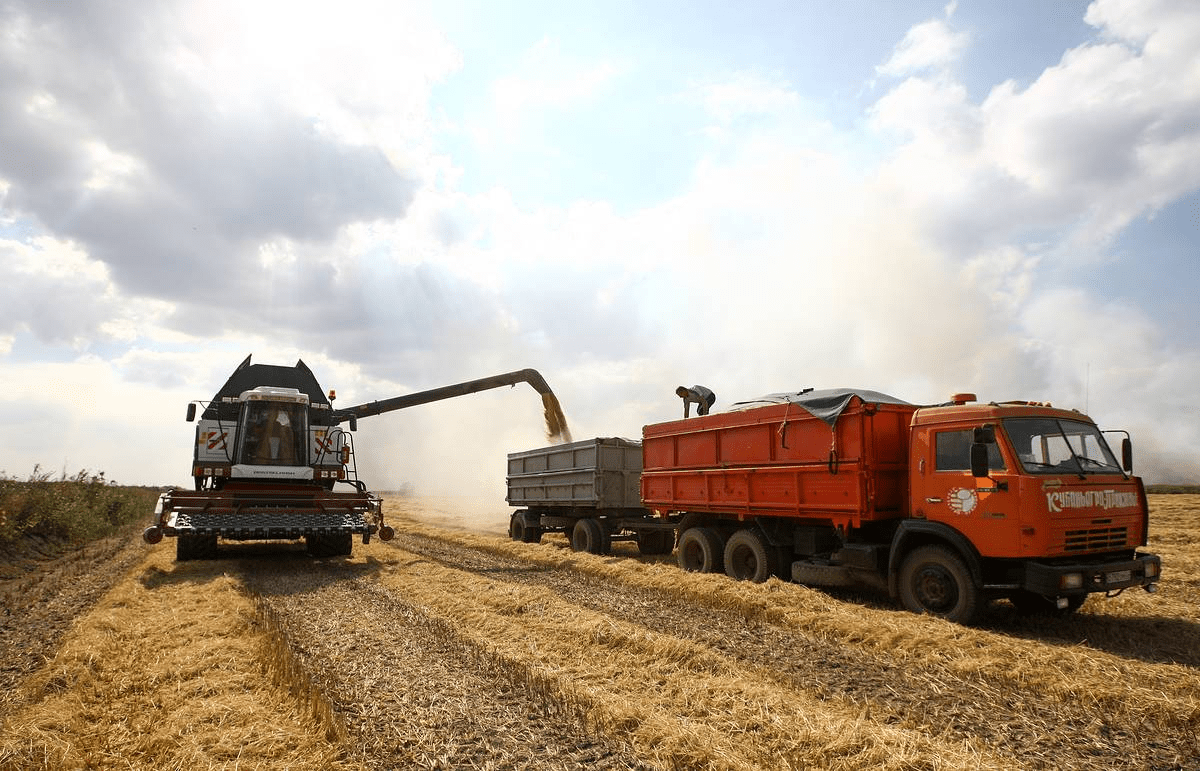
Dry conditions in parts of eastern Europe and central Asia have impacted wheat yields. Photo: Andrey Sizov/Twitter
HARVEST of this season’s Black Sea winter crop is progressing well with yields steadily improving as headers move north. However, hot and extremely dry weather across Siberia, and the neighbouring cropping regions of Kazakhstan, in the past six weeks is fuelling concern that spring wheat yields will be lower than forecast.
The Russian Ministry of Agriculture reported last week that the wheat harvest had reached 35.3 million tonnes (Mt). This is in line with the quantity reaped at the same time last year, but the area covered is greater as yields to date have been lower year on year.
The first areas to harvest in Russia are the southern reaches of the Southern Federal District, between the Caspian Sea and the Caucasus Mountains. This area was affected the most by late frosts and an extremely dry spring and the crops suffered accordingly. Early wheat yields came in at around only 3 tonnes per hectare (t/ha), about 30 per cent below last year’s levels.
Yields in the highly fertile Kuban district, which is in the north-west of the Southern Region, bordering the Sea of Azov, have fared much better. Harvest in that area has concluded, and the wheat yields averaged just over 4.9t/ha. Yet, this was still 10pc lower than 2019, and was the lowest average yield for the district since 2012.
Consequently, with more than 40pc of the Russian wheat harvest completed, the average wheat yield now stands at around 3.5t/ha. The upward trend is expected to continue as harvest moves into the Central District and Volga Valley, both of which are forecast to have bumper harvests.
Dry in Siberia, Kazakhstan
The red flag for Russian wheat production has now turned to Siberia, the country’s largest spring wheat-growing region. The crop was planted into moisture and got off to a reasonable start, but late June and July have been hot and dry. Soil moisture levels are now very poor, and spring wheat production forecasts will continue to fall in the absence of substantial rainfall over the next few weeks.

An unsually hot and dry summer in Siberia has reduced wheat yields, as well as making for a fierce bushfire season. Photo: Greenpeace Russia
Traditionally, the early Russian wheat yields set the harvest high, and the trend is downward thereafter. This season is panning out to be the opposite. Despite the poor start, and the spring wheat issues, it is highly possible that this season’s average wheat yield could get close to that of last year’s harvest. And with a bigger planted area, final production should comfortably exceed the 73.6Mt produced in the 2019 campaign.
Yield forecasts for the Russian crop appear to have stabilised, with recent downgrades reflecting the negative seasonal factors. The International Grains Council released its latest world wheat numbers last week, cutting Russian wheat production by 1Mt to 78Mt. This compares to the most recent USDA estimate of 76.5Mt, IKAR’s figure of 78Mt, up 1.5Mt this week, and SovEcon’s updated number of 79.7Mt, down from 80.9Mt.
Like Siberia, wheat production in Kazakhstan is on the slide with current soil-moisture reserves inadequate to finish the crop. The US Ag Attaché in Kazakhstan is now calling wheat production 11.8Mt, down 700,000t from its previous estimate. This is 1.7Mt lower than the most recent USDA forecast. Export forecasts for the 2020-21 marketing year have also been revised down by 900,000t to 6.2Mt.
Ukraine’s 2020 grain harvest is now 38pc complete, with total grain production expected to be 9.5pc below last year’s record-breaking haul due to unfavourable weather conditions in the Odessa and Crimea regions.
Ukraine has harvested 12.8Mt of wheat so far this summer with total production expected to be around 24.7Mt according to the US Foreign Agricultural Service. This is a fall of 15pc compared to the 2019-20 harvest and is 1.8Mt lower than the July USDA estimate. July 1 wheat stocks were reported at a 10-year low of 1.8Mt.
Russian farmers hold back
Interestingly, Egypt purchased 115,000t Ukrainian wheat for late August delivery at its most recent tender, after purchasing the same quantity from Russian exporters the previous week for mid-August delivery. Last week’s result reflects the lack of grower selling in Russia. The farmers there simply do not want to give up the world’s cheapest wheat amid increasing crop uncertainty, and the trade doesn’t want to extend shorts against a stubborn seller.
Russia has been busy courting Brazil. Russia’s July wheat loadings for Brazil amounted to 70,000t, and there’s more on the books. This compares to sales of 90,000t for the entire 2019-20 marketing year. Russian wheat exports for July are forecast to be as low as 2.2Mt compared to almost 4Mt in the same period last year.
Black Sea price rally
Nearby Black Sea wheat free on board (FOB) prices started last week lower, but rallied in the back end to be quoted unchanged at around US$208-211/t FOB, 12.5pc protein, $4/t lower for 11.5pc protein, and feed wheat was $4/t lower again. However, cost and freight (C&F) sales during the week seem to reflect much lower values, unless sea freight rates are easing. Current carry costs in the market would put January FOB values around $12/t higher.
Prices out of the Black Sea have rallied approximately 7pc this month, despite the pressure of new-crop harvest supply. Exporters with short positions in the FOB market have been trying buy cover, pushing prices higher.
Australian on the money
New-crop Australian export values firmed slightly across the week. Western Australian values were up a couple of dollars, with Kwinana APW quoted at around US$239/t FOB. South Australia rallied $5/t, with Port Adelaide quoted at US$238/t FOB and Melbourne/Geelong was unchanged at a slightly lower quote of $236/t FOB. Lower-protein ASW wheat is around US$10-15/t lower, depending on the load port.
At those price relativities, Australian wheat is currently in the money into traditional South East Asia markets. Two conflicting questions remain: When will the weight of new-crop volume and export competition loosen the Russian farmer’s grip on wheat stocks, pressuring Black Sea values lower? Or, will smaller surpluses among the major global wheat exporters hold prices firm as we move into the southern hemisphere spring?
Grain Central: Get our free daily cropping news straight to your inbox – Click here

HAVE YOUR SAY